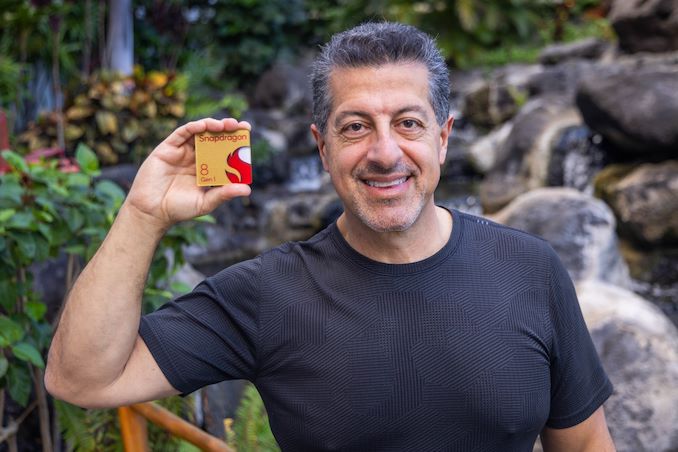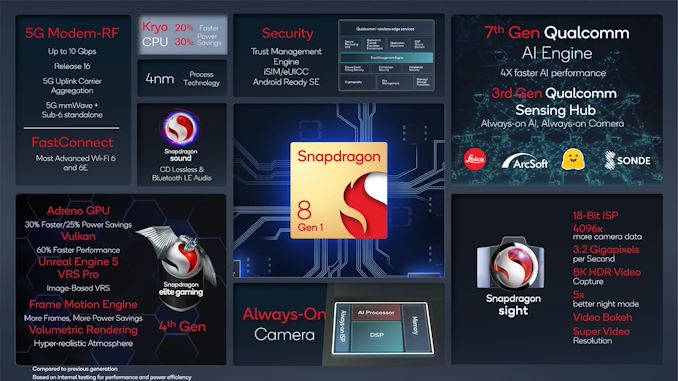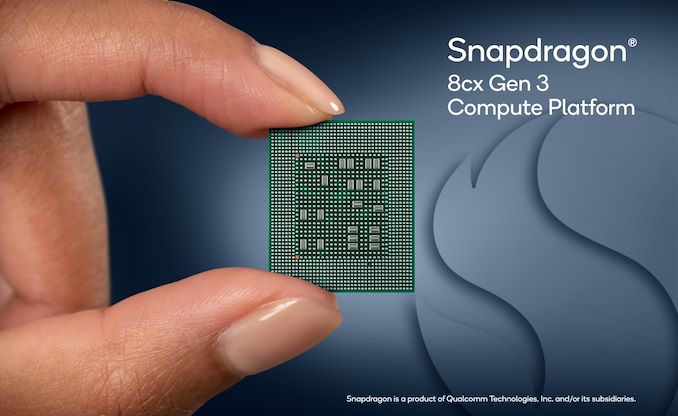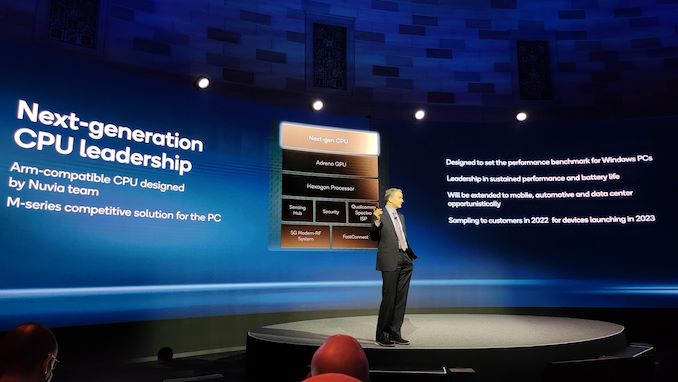Interview with Alex Katouzian, Qualcomm SVP: Talking Snapdragon, Microsoft, Nuvia, and Discrete Graphics
by Dr. Ian Cutress on January 31, 2022 10:00 AM EST- Posted in
- SoCs
- Snapdragon
- Qualcomm
- Smartphones
- 5G
- ACPC
- Interviews

Two driving forces are driving the current technology market: insatiable demand for hardware, and the supply chain shortages making it difficult to produce enough in quantity to fulfil every order. Even with these two forces in action, companies have to push and develop next generation technologies, as no competitor wants to sit on their laurels. That includes Qualcomm, and as part of the Tech Summit in late 2021, I sat down with Alex Katouzian, Qualcomm’s GM of Mobile, Compute, and Infrastructure to talk about the issues faced in 2021, the outlook for 2022, where the relationships lie, and where innovation is headed when it comes to smartphone and PC.
We’ve interviewed Alex a couple of times here at AnandTech, and while he has been well trained in dealing with the likes of our pointed questions, we can tell he’s being open and honest, telling us as much as he can (and sometimes a little bit extra). Alex has been at Qualcomm for 20 years, working his way up through wireless mobile technologies, product management, and taking over the MCI business unit in 2017. Prior to that Alex was engineering multimedia and wireless chipsets, showcasing that his whole career has been about putting next-generation connectivity into as many gadgets as possible.
 Alex Katouzian SVP and GM Mobile |
 Ian Cutress AnandTech |
Ian Cutress: Here at Qualcomm’s Tech Summit, you are announcing the new Snapdragon 8 Gen 1, with new marketing, and it’s a new chip on Arm v9. I kind of want to step back and look at the year as a whole – Qualcomm launched the Snapdragon 888, and that's been in a lot of flagships, accompanied by a lot of them with Qualcomm 5G RF solutions. I know you're an employee, and I know you're probably biased, but objectively what grade would you give Qualcomm for the year?
Alex Katouzian: Well our Snapdragon 888 is top in premium tier solutions. When you look at the capabilities that were available to our customers and ecosystem through the technologies we provided, we topped the chart in terms of graphics capability, overall performance, AI capability, and camera performance - there are multiple phones on the 888 that are topping out on DXOmark. I would say our Elite Gaming capability was very good, we’ve done that in cooperation with the developers and game engine developers. All of them were very cottoned on. So overall, I would say a pretty high grade on the overall performance of a premium tier phone.
IC: Would you say you've had any pinch points this year, that get solved next year?
AK: Obviously the pandemic brought on some supply chain issues, and the severity of them fluctuated throughout from the end of 2020 through into 2021. But by being a fabless company, it allowed us the freedom to be able to move from fab to fab, not only on the latest digital parts of technology, but also on the old analog technology we've had the ability to move from fab to fab as well. We alleviated a lot of the supply issues based on the ability to have engineering resources available to move parts and make room for shipments to happen. Even though we still went through some supply crunches, and we probably will go through some supply crunches in 2022, we alleviated a lot of that, and we are able to get out our products.
IC: Does moving from fab to fab like that disrupt the unique relationships with each foundry?
AK: The relationship between a fabless semiconductor company like us and the foundry has to be very tight. But these were unprecedented times, and the ripple effects were great because the supply chain usually takes about 18 months to 2 years to come to fruition. When we had that shutdown period of say, 9-10 months, every facility in the supply chain was shutting down. They had to restart that, to recalibrate equipment, to hire staff, and any expansion plans were on hold. Then the surge in demand for consumer electronic equipment was so high that it takes time for it to catch up. Given these ‘unprecedented times’, I don't think that a foundry is going to blame a company like us to try to diversify in such a way that it allows us to ship products. If you look further down the supply chain, we are suppliers to our customers, and they're gonna have to diversify in their supply as well, and someone had to make that choice.
IC: Aha, so goes both ways, both up your chain and down it.
AK: Exactly!
IC: So when I came to my first Qualcomm Tech Summit, the venue had specialist equipment installed for 5G because we were still very early, very nascent in 5G. The rollout at the time was more focused on industrial applications, but a good amount of the talk was on mmWave versus Sub-6. Where the US is focusing on mmWave, the rest of the world was focused on Sub-6. If feels kind of odd, but we're kind of still having those discussions! What has changed from Qualcomm’s point of view in those discussions?
AK: I think more and more, the carriers are realizing that ‘a layered cake effect’ of their network, spreading out, becomes a more necessary thing to do in crowded environments or congested areas. mmWave roll-out, even though sometimes it a little bit more difficult because the amount of base station towers, you have to have a lot more of them, even though they are a little bit more difficult, carriers are realizing that it actually is much better to have mmWave in congested areas. Then, as you go further out to more suburban areas, that Sub-6 can cover and even more, maybe possibly even falling back to LTE.
But that realization, and the deployment of the equipment - remember, we're at the end of the second year of the commercial release of 5G, and for every G, the transition takes between 10 to 12 years. So the rollout of mmWave is going to start to happen more. I think more countries are going to start to deploy: we have deployment in Japan; Korea is slowly starting to come up; China's starting to think about the fact there's lots of bandwidth available there for them. Then the sectors that mmWave can get applied to are so much wider than what we had before, in different sectors of say economy, manufacturing, retail - and then you have other means of deploying mmWave to private networks via small cell. Those are all helping. I think when you look at industrial, when you look at manufacturing, when you look at automotive, there’s a lot of room to grow for mmWave, and that expansion is going to be from the ecosystem.
IC: For this event, we're learning a lot about Snapdragon 8 Gen 1. As you've said, and as the numbers show, you guys are a premium smartphone leader, continuing from the previous generation. In my mind, I'm juggling up the fact that as a premium leader, you want to maintain the market share, but you also need everything to work to maintain unit sales. So on some level, you have play it safe to make sure you have that product working correctly - but on other levels, you have to take risks with new features, and next generation technologies that may or may not work long term. Compare that to all your competitors that are trying to catch up, and can take those risks. How exactly do you balance that? Is there a right way to talk about how that is balanced?
AK: I think the way to look at it is that the strategy at Qualcomm has been to take the risk on the technology on the largest channel that you have, and then re-use that technology in products in growth sectors that are adjacent to our largest channel. So mobile is obviously the largest segment we have at Qualcomm - so you will see the risk taking in advancing technology in mobiles first, even though when you're looking at a mobile first environment, power dissipation should be top of mind. However, let's say I want to apply AI capability to mobile, power is the number one criteria. Then I can figure out my performance to power ratio, and I can scale from there. But if I want to look at automotive, and I want to do autonomous driving, performance is the first criteria, power is the second criteria, maybe even the third. However, we have the ability to scale with our technology roadmap, so when we take the chance and the risk of putting certain technologies in mobile, we start to think about what the applications are so we take that risk, we put it in, and see if we can grow that market. Then we can figure out how to scale the base design into a market that needs performance first, and power second. So that's how we look at it across the board.
It's the same exact application on CPU - if you remember, a few years ago, we had our architectural license with Arm. We brought in on our own CPU, and we took advantage of that, and we kind of tried to grow the market. At that time, we didn't have adjacent businesses that we were really growing - we were thinking about them, but we weren’t growing them, but the application is exactly the same. Now with Nuvia coming on board, we're going to do the same thing you know – a ‘one technology roadmap’ that can scale. We will first have that first instance of that in a PC chip sampling next year, getting to products in 2023. Then we're going to think about how to bring it into mobile, automotive, and then infrastructure application as well. So we’ve already thought about how to do the power performance scaling for different businesses we’re going after. Same with graphics, same with camera capabilities, same with video capabilities. Each of these technologies take the risk of it being introduced in mobile first, scale it, think about other markets that we go to and then we adjust our performance and power points.
IC: It's great that you said video capabilities, and speaking about the camera, because one of the points that came out of the presentations and some of our briefings is that Qualcomm is pushing 8K HDR, and more advanced 4K HDR recording. But the silicon doesn't have an AV1 decode unit, and some people have said that it is because you guys aren't part of the AV1 Alliance. Can you shed some more light on the decisions there?
AK: So when we plan our technologies out, sometimes on devices such as the premium tier, we have to think about things two or three years in advance. The timeframe that we need to introduce these devices is very critical based on the OEM launches, and the needs of the carriers. Given those circumstances, we haven't been able to accommodate AV1. We'll probably accommodate in the future, but up until now, we just haven't been able to do it. It’s not that we don't want to do it - we just haven't had the ability to plan it in in time to try to make that happen.
IC: But you’ve got people working on it?
AK: Oh, yes - we have multiple video experts. I mean, we contribute to standards on video constantly. We're involved with where it's heading. We just think that in time, we'll have those capabilities - there's no doubt. We just didn't have the opportunity to get it in time schedule-wise, planning it in such a way that it will hit our timeline.
IC: When it comes to relationships - Qualcomm and Microsoft. The Windows on Snapdragon ecosystem is a long partnership, and we're now seeing 64-bit emulation coming with Windows 11, enabled with last-gen devices and future devices. How's that relationship progressing? You’ve had Microsoft on stage at this event!
AK: Extremely well. Our partnership with Microsoft has always been solid, in terms of a cloud-and-software company cooperating with a technology-and-hardware company, to provide a solution that makes sense for the consumers. They're using all those buttons, across phones, across PC, and we're collaborating across IoT, even looking at AI capabilities, not just in phones but also in PCs, and possibly in data-center collaboration as well. However, our relationship on the PC side has been becoming more and more sophisticated as they learn the capabilities and technologies that we have. They are also taking the risk of exploring how multimedia capability can become more and more prevalent on the PC. As you know, I think you agree that mobile traits are coming to the PC and the realization that having the ability to be mobile and connected and having great multimedia, including camera, including audio, improving AI, all of that is becoming more and more important, along with performance capability of the CPU and GPU - a combination of which can become very well suited for a mobile workforce.
But let me give you a little bit of a history. Every business Qualcomm has gotten into that has had incumbents. We've had three ingredients that we've put in to meet KPIs (Key Performance Indicators). One is having a disruptive technology that can make a difference, two is a long-term investment, and three is a go to market partner. I can go as far back as UMTS - we invested in UMTS for seven years before it became more mainstream and to grow. Now, obviously, we had a disruptive approach which was a highly integrated solution with a protocol stack that was worldwide tested, and we could make more OEMs horizontal versus vertical. So we had that disruption, we put in those seven years of investment, and our go-to-market partners were the horizontal OEMs that exist today. We did the same thing for Wi-Fi, and we did the same thing for RF front end.
When we are getting into the PC market, we're doing the same thing. We have disruption, we have long-term investment, and we've been doing this for about five years now. We just invested in Nuvia, not just for the purpose of the PC, but a piece of it is for the PC, and we have our go-to-market partner in Microsoft for Windows, and we're working with Google Chrome based devices as well. So those three ingredients are met, and we’ll continue improving our devices and capabilities. This also means working with Microsoft end-to-end, to exploit all of the underlying technologies to their OS to be optimized to run on Snapdragon devices, and then drivers to expose all the technologies to users.
IC: If I could get some clarity on the relationship between Qualcomm and Microsoft. There have been public discussions regarding what you call Windows on Snapdragon (named because of the relationship, although a lot of people like to call it Windows on Arm). There have been reports saying that, between Microsoft and Qualcomm, there's been an exclusive agreement for these Windows on Arm/Windows on Snapdragon collaboration exclusivity is slowly coming to an end. Is there anything you can comment on that?
AK: I really can't comment on that, but as I said, the cooperation between us has never been this strong, and I think for the foreseeable future we're going to work with them more to increase the capabilities of Arm and/or Snapdragon based solutions.
IC: So you mentioned Nuvia a couple of times, a topic very dear to my heart. I've met with Gerard, Manu, and John pre-acquisition, and I was really looking forward to their server chip they were going to produce. So I must admit a little bit of me died when you guys acquired them, but I must applaud that it was a clever move in acquiring them. Given what Qualcomm CEO Cristiano Amon was saying at the time, saying about ACPC since its inception, it really is the direction it needs to go in. I know Nuvia is more the topic for next year's summit, as you've said sampling in 2022, product in 2023. How is that acquisition going, and how is the team integrating?
AK: Extremely well, extremely well. The founders are very active, and I can personally say I probably meet with them on a weekly basis, up to two or three times a week. My colleagues that are running the PC business within my business unit meet with them on a daily basis. We review roadmaps all the time, we review strategies, we are very cooperative on how to go to market, not just in the near future, but in the longer term as well. The system architecture, the chipset architecture, are all being discussed continuously - partitioning is being discussed continuously, so it's a very tight integration of this team, and that's exactly how it also happened in the past. For example, we bought two Wi-Fi companies, one is Atheros. We integrate those teams in within the Qualcomm group and kind of make them one Qualcomm, and then we proceed that way. That's exactly what's happening with the Nuvia team as well. And I would say, on the server side, that those are opportunistic businesses that we’ll go after. So we’ll see what happens.
IC: Will the Nuvia core be called a Kryo core, or will you have any fancy marketing name for it?
AK: I haven't thought about it yet – it definitely won't, or probably won’t, be Kryo. But we haven't thought about it yet.
IC: Give me a call when you need a name!
AK: Hah, sure!
IC: If you can perhaps clear something up for me: is the Nuvia team making a single core, or both a big core or a little core? Or is it that they’re dealing fully with the SoC structure into which you add in the connectivity and the graphics?
AK: It’s both, all the above. By that I mean that it's impossible for us to put out a chipset solution as sophisticated as this without having the entire system being taken into consideration. Think of it this way: the CPU by itself is part of the ‘one technology roadmap’, but so is graphics, and other things. Then we're really thinking about bringing a complete system solution to the PC and changing it in such a way that you don't go after the traditional designs. You know, we talked about this before, we're looking for bill of material savings, we're looking at design savings, we're looking at internal routing, we're looking at shell designs, and we’re looking at thermals - the whole thing. So it has to be a complete solution. So they're definitely involved in the whole SoC design, and they're involved in looking at multiple different cores, where it makes sense. Whether it's big cores, little cores, or a combination of how many.
IC: Nuvia’s design will be Arm-based, and the Nuvia team comes from people who built Apple’s M1 and talent from Google. So will that chip compete primarily against Apple because it's ARM-based, or against Intel because it's Windows-based?
AK: The devices that we're going to come out with based on the new CPU design and the new architecture, will compete head on with Apple.
IC: So when you do your comparison charts, you'll be comparing against Apple?
AK: Yes.
IC: Is that because Intel is no longer in the picture? Or is that just because that’s where the market is?
AK: The way we look at it is that we're not going after discrete designs: we're going after an SoC and the architecture that makes the best sense for the PC. Like I said, mobile traits are coming into the PC, and I agree with you that performance wise compared to mobile it’s much higher, it has more power dissipation capability, but we're going to try to make it a lot sleeker and have a lot more mobile based. So our comparison is to a company that can do both types of SoC and bring that capability to the PC, so we're really preparing ourselves for that.
IC: Qualcomm has a very efficient graphics architecture in Adreno. It usually performs really well in the mobile SoCs, but we're currently at a time where the discrete GPU market is going bananas, and everything is selling. I would love to see a scaled Adreno GPU, and given that Intel is also coming out with its own, Qualcomm could be an amazing fourth competitor in that space. We would love to get your comments on that, but the key thing is: if you were to do that, what color would it be? AMD is red, Intel is blue, NVIDIA is green, and so is an Adreno discrete GPU going to be gold?
AK: It's hard to say because we don't even have that product! But if you think along the lines of premium, yeah, you know, it would be some shade of gold. But think of it this way: we have to enter the PC market with a very sophisticated design that we've already worked on SoC-wise till now, but we're going to get a boost when it comes to CPU capability. We can scale our GPU capability just like we discussed before, and we have the ability to scale across these devices. So we definitely will have much more performing GPU and CPU cores. Obviously also concentrating on power dissipation, and those ratios have got to be right, so if we pick a design point within the PC, we'll definitely need those requirements. Then we can break off at discrete GPU if the business makes sense for it, but we definitely have the capability to scale to that level and the design capability to produce something in that market. Plus, the hard play is about having much more of an ecosystem. So once we get into the market more heavily, and get more games developed on there for example, and other applications, then, the possibility always existed.
IC: To me, it’s a no brainer! Excellent, thank you so much Alex for your time.
AK: Thanks Ian!
We have an upcoming interview with Qualcomm's Miguel Nunes, Senior Director of ACPC, about the future of that line of products. Say tuned!














81 Comments
View All Comments
GeoffreyA - Sunday, February 6, 2022 - link
As you can see, I am terribly uninformed and out of touch with gaming and the graphics industry, and perhaps was judging it not from facts but perception. What I saw was a difference in degree, not kind, whereas in the old days, going from say Quake III to Doom 3, it was evident new technology was at work.I must say, I hadn't heard of path tracing, and of PBR only in passing as a term, but path tracing seems particularly intriguing to me. Just the sort of thing games are in want of. As for the motion picture industry, I can't resist commenting that films have never looked more fake than today. They should just do away with actors altogether and let ILM make the whole film in the studio.
GeoffreyA - Sunday, February 6, 2022 - link
(To cite just one example, the scale models of 1968's "A Space Odyssey" make a laughing stock of today's hi-tech CGI gunk in movies.)Kangal - Sunday, February 6, 2022 - link
You guys are an odd bunch.You started about debating x86 vs ARM, which morphed into power draw debate, then morphed into graphics debate, which then morphed into tech history. There's no real consistent argument here.
At the end of the day, the hardware matters but it means nothing if you don't have the software for it. There is code that runs on both x86 and ARM. So this isn't even a CISC vs RISC problem.
mode_13h - Monday, February 7, 2022 - link
> You guys are an odd bunch. ... There's no real consistent argument here.With so few articles being published on this site, the situation is ripe for discussions to meander. As long as it's good-natured and topically adjacent, I don't see a problem.
Kangal - Monday, February 7, 2022 - link
I guess.But all this postulating is due to two big factors:
- x86 performance and efficiency plateau
- ARM performance and efficiency exponential growth
If hypothetically ARM SoCs were today still floundering around the Cortex A17-to-Cortex A57 level of performance and efficiency. Whilst both Intel and AMD managed to develop their processors to keep the relative performance but at only one-third of the power requirements. In other words, they flipped.
The landscape would be vastly different. People wouldn't care much about iPhone and Android as they do today. We wouldn't see any pressure to have macOS or Windows running on ARM. And people wouldn't be that interested in porting emulators to ARM.
Instead, there would be efforts to try to build a modern smartphone with x86 internals. That way it becomes Omni. Can do your light tasks and calls, but could get docked in your Office or Home, where it transforms into a full-fledged Working PC. Or gets docked to your TV and becomes a Gaming PC.
Since we are where we are, we need to acknowledge the limitations for such ambitions (either port everything to ARM)(or go all-in with Cloud Computing). It's a bit meaningless to discuss how x86's evolution in gaming applies to the current state of ARM.
GeoffreyA - Tuesday, February 8, 2022 - link
Popular wisdom has it that ARM, in all its shiny glory, is the future of computing, heaps of performance just waiting in its Apple-run tanks. But Nature shows that everything reaches a diminishing return, and why not ARM too, if it hasn't done so already? Apple Silicon is fast, we admit, but Intel and AMD aren't very far behind. In the larger picture, there isn't much of a difference. I think what's happening is that computing is reaching a limit, under the current scheme of things, and no amount of shuffling will change that. It's physically evident in manufacturing, and doubtless computation, too, has some obscure limit, consistent with the world we live in.As for cloud computing, it's had brilliant success and is great, but people need to ponder what it means to have the world's calculations centred in the hands of a few big companies.
mode_13h - Tuesday, February 8, 2022 - link
> Nature shows that everything reaches a diminishing return, and why not ARM tooI think x86 will run out of gas before more modern ISAs, like ARMv9 and maybe RISC-V. Kangal's point about the inferior perf/W of x86 is good evidence of this fact.
Let's wait and see what Qualcomm/Nuvia can actually deliver. Mediatek has also promised to deliver ARM SoCs with Nvidia graphics for small form factor NUC-like desktop machines. That should prove interesting.
On the RISC-V front, Intel just joined the foundation as a Premium member. So, that deepens their investment in the ISA.
Kangal - Tuesday, February 8, 2022 - link
And ages ago Intel was also the owner of Moblin, and were collaborating together with Nokia to make a Linux Distribution, that was open-source, modern, and ready for the next-generation of devices (eg iPhone 4, iPad 2, ThinkPad Helix, etc etc). They called it MeeGo. What ended up happening is they stifled development, much to the dismay of Nokia, who ended up releasing a bastardised version on the Nokia N9 and Nokia N950. Then the entire project (MeeGo) was scrapped, Nokia was sold to MS, and Intel was happy to continue their partnership with Windows.So Intel joining RISC-V is not a good thing. In fact, I see it as a negative.
As for the future of computing?
I think ARMv9 will soon surpass AMD and Intel with higher performance AND lower energy drain, on all markets: watches, phones, tablets, laptops, desktops, servers. However, it won't matter much for AMD or Intel, at least not for another 5-10 years. They can still push forward to 128-bit, 3D Stacking, better lithography binning, overclocking, and stronger cooling. So there's still some runway left.
My postulation?
We will hit the atomic limits of Silicon. And will have to move away from processing with electrons, to photons/light, by having microaturised lasers. And/or we will move away from Binary Computing into Quantum Computing. Specifically speaking Ternary Computing aka Base-3. So instead of an On/Off state, it will be a Negative/Neutral/Positive Charge state. So it will be a trit instead of a bit, or a tryte instead of a byte. In particular, a 27-trit computing (higher efficiency) and 81-trit computing (higher performance) will be the targets in the coming decades when we've ran out of runway on x86, Silicon, and Binary Computing.
GeoffreyA - Wednesday, February 9, 2022 - link
Using photons could be the next step; but on the other hand, electrons already are able to reach a sizeable piece of the speed of light, so at best, light-based CPUs might only be marginally faster and come with tradeoffs of their own. I also think there's a practical limit to computation itself, and we're now scraping the surface of that coffin. If the universe is being computed, we can't operate faster than that.Will quantum computers replace classical ones? For my part, I doubt it, the two excelling at different tasks: QCs in the realm of probability, and classical computers where exact answers are needed. In every quantum thing, there always seems to be a classical touchstone, which shows that these two realms operate at different levels.
My computer science is rather weak nowadays to hazard a guess on the base-3/binary question, but my feeling tells me it would complicate things a great deal, be slower, and goodness gracious me, what an upheaval in so much code!
GeoffreyA - Thursday, February 10, 2022 - link
"electrons already are able to reach a sizeable piece of the speed of light"Realised this mistake only afterwards, that they're certainly not going to reach such velocities in silicon.